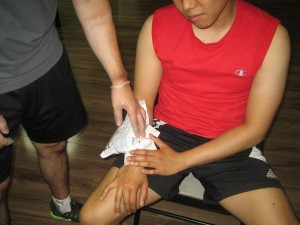
Sprained wrists are damages to the ligaments found in the wrists. Sprains are damages to the connective tissue connecting the bones to one another, also called the ligaments. Wrist sprains are a fairly common injury that occurs when the wrist is forcefully bent.Sprained wrists are most common in athletes but may also occur to anyoneOne of the most commonly sprained ligaments is the scapho-lunate ligament, the ligament connecting the scaphoid and lunate bones. The degree of the damage to the ligaments will determine its grade and the necessary treatment for complete healing.
Sprained Wrist Grades
Grades are dependent on the extent of the damage to the ligaments. Grade 1 is considered the mildest, whereas grade 3 is considered the most severe.
- Grade 1
- Stretching of the ligaments but no tearing or microscopic tearing only
- Grade 2
- Partially torn ligaments
- May lead to slight loss of function
- Grade 3
- Completely torn ligaments
- Often require medical or surgical care
Causes of Sprained Wrist
The following may lead to an excessive force or loading to transmit across the wrist resulting to sprained wrist.
- Falling onto an outstretched arm
- Twisting the wrist
- Getting hit on the wrist
Symptoms of Sprained Wrist
There are many ligaments in the wrist and any damage to them may lead to any of the following symptoms that are typically associated with sprained wrists:
- Swelling in the wrist
- Immediate pain and tenderness
- Pain that moves when moving the wrist
- Bruising or discoloration and warmness of the skin surrounding the wrist
- Popping or tearing feeling inside the wrist
- In severe cases, deformity
First Aid Management for Sprained Wrist
Only torn ligaments will require medical or surgical care. For stretched ligaments, efficient home treatment will suffice. First aid can be given at initial onset of symptoms to reduce symptoms caused by sprained wrist:
- For cases of strains, sprains and broken bones, follow the RICE method.
- Rest the affected wrist and avoid doing any more activities.
- Ice the affected area for 15-20 minutes thrice daily. Wrap the ice in a towel or any cloth.
- Compress the affected wrist using a compression bandage to limit swelling.
- Elevate the affected area above heart level, also to limit swelling.
- Wrap the wrist with an elastic bandage.
- Take over-the-counter pain and anti-inflammatory medications such as paracetamol, ibuprofen or aspirin to help alleviate pain.
- Immobilize the affected wrist by using a cast or splint.
- Drink plenty of water to help ease pain.
- Stretching and strengthening exercises may be recommended by the doctor.
Disclaimer: This article does not provide medical advice or treatment. The information given should not be used for self-diagnosis of the possible conditions. Seek medical attention when necessary. To learn more about how to give first aid for sprained wrist and other tissue problems, enrol in First Aid Courses with workplace approved training.
